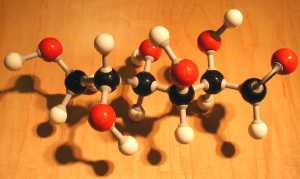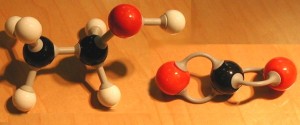Milk is extremely perishable and many means have been developed to preserve it. The earliest one which has been used for many thousands of years is fermentation. Milk can be fermented by inoculating fresh milk with the appropriate bacteria and keeping it at a temperature which favors bacterial growth. As the bacteria grow, they convert milk sugar (lactose) to lactic acid. You can detect its presence by the tart or sour taste (sour is how we taste acid). The lowered pH caused by lactic acid preserves the milk by preventing the growth of putrefactive and/or pathogenic bacteria which do not grow well in acid conditions.
FERMENTATION
Fermentation is a means by which cells growing anaerobically can still generate a little ATP. Fermentation is defined biochemically as the catabolism of glucose (or other sugars) in which the terminal hydrogen acceptor is an organic molecule (carbon containing). During the breakdown of sugar, known as glycolysis, excess hydrogen atoms are generated and must be deposited somewhere. In lactic acid bacteria, they “dump” excess hydrogens on to pyruvic acid, the end product of glucose. This turns pyruvic acid into lactic acid.
Our muscles do the same thing, which causes the sting in over exercised muscles. In all fermentation, NADH gives up its hydrogen to produce NAD, which is required for further glycolysis. Yeast too performs fermentation, but with different terminal hydrogen acceptors (acetaldehyde) and products (CO2 and ethanol). You will note that alcoholic fermentation is also an anaerobic process. Since the terminal hydrogen acceptor in each of these microbiological processes is an organic molecule, they are, by definition, fermentation.
In contrast, respiration uses an inorganic terminal hydrogen acceptor (such as oxygen). If oxygen is the acceptor, then water is produced.
Casein, the predominant protein in milk, is soluble at a neutral pH, but insoluble in acid. Thus when milk sours, casein precipitates which thickens the product. Numerous strains of bacteria are capable of converting lactose to lactic acid. We will look at several fermented milk products to study their morphology and staining characteristics.
- Make a thin smear of each milk product well spaced on the same slide, labeling with a wax pencil Y, B and S. (see protocol Smear and Staining of Bacterial Specimens)
- Stain them according to the procedure for the Gram stain (see related protocol Gram Stain Protocol), or any simple stain such as methylene blue, should you only be interested in seeing bacterial morphology.
- View the stained smear at 400x to determine the characteristic features, select a field which is well spread and typically stained. Then switch to 1000x with oil. (The oil immersion lens is challenging to novices. Do not use this lens unless you have been instructed in its use.)
- Illustrate typical fields for each milk product showing all observed morphologies of bacteria. Label the morphologies and their probable identities according to the following type of bacteria expected in these fermented milk products:
YOGURT
Yogurt is produced by a mixed culture of two types of bacteria. Imbedded in particles of the protein casein, you will see chains of cocci or diplococci (Streptococcus thermophilus) and big rod-shaped bacilli (either Lactobacillus acidophilus or L. bulgaricus). If you do a Gram stain, the bacteria will be Gram positive (purple) and the protein will be pink. The illustrations at the top of the page are micrographs I took of a Gram stain of yogurt. The purple rods are Lactobacillus, the purple spheres are Streptococcus. The pink globs are casein, milk protein.
BUTTERMILK
Buttermilk is the fermentation of milk by a culture lactic acid-producing Streptococcus lactis plus Leuconostoc citrovorum which converts lactic acid to aldehydes and ketones which gives it its flavor and aroma.
SOUR CREAM
Sour cream is produced by the same bacteria as buttermilk, but the starting milk product is pasteurized light cream. Bacteria are less numerous than in buttermilk.







